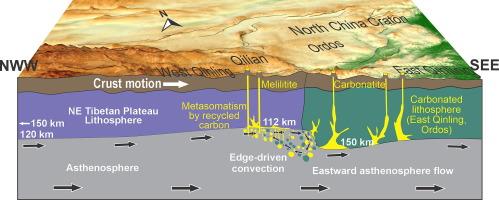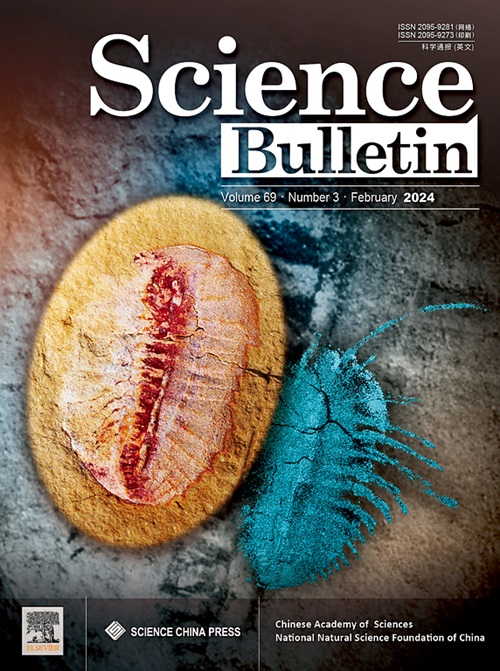Asthenospheric flow and lithospheric erosion driving the outward growth of the northeastern Tibetan Plateau
IF 21.1
1区 综合性期刊
Q1 MULTIDISCIPLINARY SCIENCES
引用次数: 0
Abstract
The northeastern (NE) Tibetan Plateau is extruding eastward at a rapid rate (∼15 mm a−1), but the role of the upper mantle in this process remains unclear. Early-Miocene primary melilitites from the leading edge of the extruding plateau provide critical insights into the upper mantle dynamics. Geochemical and Sr–Nd–Pb–Os isotopic data, supported by experimental melt comparisons, reveal that these melilitites originate from a hybrid source of CO2-bearing mantle source, probably dominated by peridotite and pyroxenite/wehrlite lithologies. This is consistent with carbonate minerals found in mantle xenoliths (peridotite + pyroxenite) entrained within the melilitites. Geothermobarometric calculations indicate magma generation at 116–135 km depth, below the lithosphere-asthenosphere boundary (∼112 km) constrained by xenoliths and seismic data. Isotopic data trace the carbon origin to a carbonated lithosphere associated with the 150-km-thick eastern tectonic blocks. Recent seismological studies suggest that eastward-flowing asthenosphere beneath the northeastern Tibetan Plateau is actively eroding the thicker lithosphere (150–200 km) of the eastern blocks. We propose that this asthenospheric flow not only thins the lithosphere but also mobilizes carbon from the eastern carbonated lithosphere into generating the melilitite, likely via edge-driven convection. The resulting melilitite compositions is therefore a petrological record of these dynamic processes. This study highlights the critical role of upper mantle processes—astenospheric flow and lithospheric erosion—in driving the eastward extrusion of the Tibetan Plateau. It also underscores the importance of carbon mobilization in understanding mantle carbon cycling during continental collision.

早中新世来自挤压高原前缘的原生千粒岩提供了对上地幔动力学的重要见解。地球化学和Sr-Nd-Pb-Os同位素数据,以及实验熔体对比结果表明,这些溶出石可能来自含co2的混合地幔源,可能以橄榄岩和辉石岩/辉石岩岩性为主。这与地幔捕虏体(橄榄岩+辉石岩)中的碳酸盐矿物一致。地温气压计算表明岩浆的产生深度为116-135 km,低于岩石圈-软流圈边界(~ 112 km),受捕虏体和地震数据的限制。同位素数据显示碳的来源是与150公里厚的东部构造块相关的碳酸岩石圈。我们认为这种软流层流动不仅使岩石圈变薄,而且可能通过边缘驱动对流从东部碳酸化岩石圈调动碳来产生千粒岩。由此产生的千晶石组成是这些动态过程的岩石学记录。它还强调了碳动员对理解大陆碰撞过程中地幔碳循环的重要性。
本文章由计算机程序翻译,如有差异,请以英文原文为准。
求助全文
约1分钟内获得全文
求助全文
来源期刊

Science Bulletin
MULTIDISCIPLINARY SCIENCES-
CiteScore
24.60
自引率
2.10%
发文量
8092
期刊介绍:
Science Bulletin (Sci. Bull., formerly known as Chinese Science Bulletin) is a multidisciplinary academic journal supervised by the Chinese Academy of Sciences (CAS) and co-sponsored by the CAS and the National Natural Science Foundation of China (NSFC). Sci. Bull. is a semi-monthly international journal publishing high-caliber peer-reviewed research on a broad range of natural sciences and high-tech fields on the basis of its originality, scientific significance and whether it is of general interest. In addition, we are committed to serving the scientific community with immediate, authoritative news and valuable insights into upcoming trends around the globe.
 求助内容:
求助内容: 应助结果提醒方式:
应助结果提醒方式:


